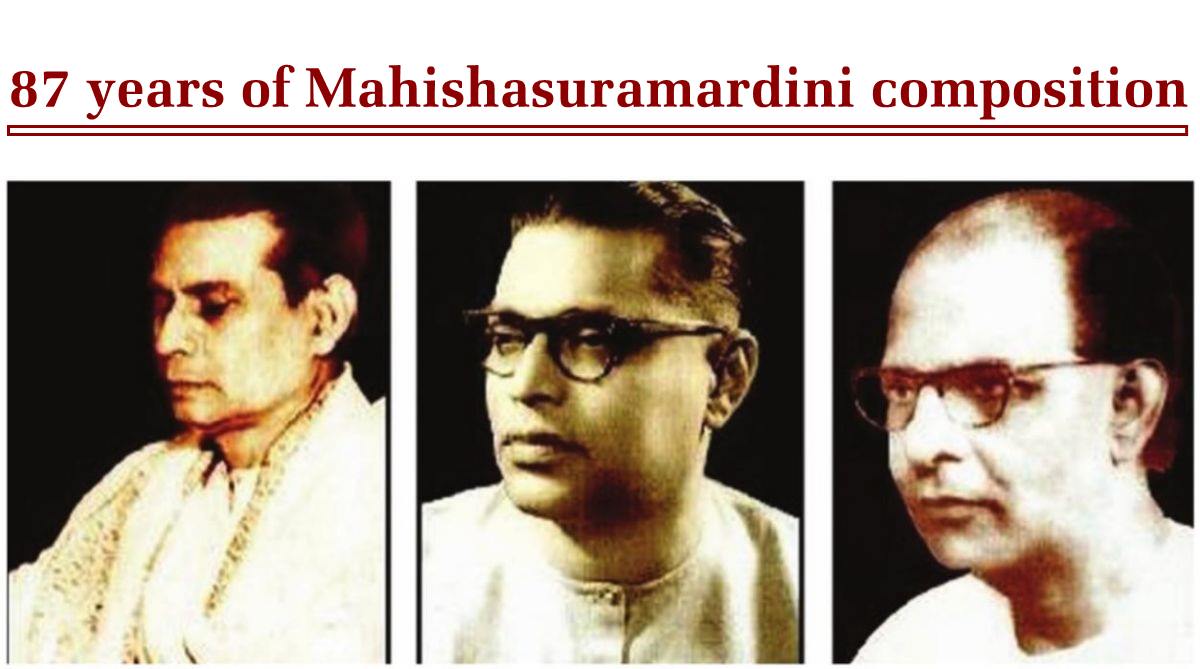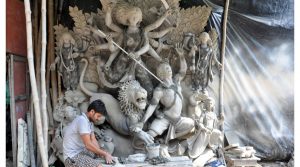Mahalaya film review: Making a cultural statement
The film shines a light on the true incident in 1976 when matinee idol Uttam Kumar replaced the iconic voice of Birendra Krishna Bhadra for Mahishasuramardini
For the last 87 years now, Mahishasuramardini recital has enthralled Bengalis across the world, standing the test of time fighting all kinds of modern influence on music
SNS | New Delhi | October 8, 2018 11:38 am

Birendra Krishna Bhadra, Pankaj Mullick and Bani Kumar
It has been nearly 90 years since music aficionados were introduced to the classic Mahishasurmardini recital played at the crack of dawn every Mahalaya. Bengalis all over the world have since listened to the timeless composition on Mahalaya, which marks the end of Pitri Paksha and heralds the beginning of the annual Durga Puja festival. Composed for radio in 1931, the 90-minute musical extravaganza is a melodious combination of hymns, narration and devotional songs describing the creation of Goddess Durga to kill the evil Mahishasur.
Eighty seven years on, the composition has retained its charm and is still popular with people from all walks of life, irrespective of age, gender and beliefs.
Advertisement
It won’t be an exaggeration to say the Mahishasurmardini composition as a chartbuster has never left the top spot. Every year, people religiously follow the ritual of getting up before sunrise to tune in to the radio stations playing Mahishasurmardini, which has become synonymous to Mahalaya.
Advertisement
The Mahishasurmardini composition has a rich narration and Chandipath by the legendary Birendra Krishna Bhadra and a medley of Bengali devotional songs by a number of popular artistes of the yore. Scripted by Bani Kumar, the composition had been set to music by Pankaj Mullick. Lending their voices to the all-time classic were Dwijen Mukhopadhyay, Pratima Banerjee, Shyamal Mitra, Sandhya Mukhopadhyay, Manabendra Mukhopadhyay, Arati Mukhopadhya, Supriti Ghosh, Bimal Bhushan, Utpala Sen, Tarun Banerjee, Krishna Dasgupta, Sumitra Sen, Ashima Bhattacharya, Shipra Bose and Pankaj Mallick himself.
READ | Durga Puja 2018: Best wishes, messages, quotes, images to share on SMS, WhatsApp
The Mahishasuramardini rendition used to be a live programme every Mahalaya, with artistes reaching the radio station past midnight for the performance. Many of the singers would later reminisce the joyous time spent rehearsing, and getting together for the much awaited performance.
The studio would be decorated with flowers, and incense sticks would be lit. Every artiste would be asked to come wearing clean washed clothes after taking a bath. Women artistes would wear the temple attire of white saree with red borders, while men would wear dhoti-kurtas. Conch shells would be blown three times before the performance began. All this created a puja atmosphere for everyone present there, and the feeling would get effortlessly transmitted into the performance.
The regime of live performance ended after the recital was recorded in 1966. The record make the creation immortal. It’s the same recorded version that is now played everywhere.
Let’s know about the three main brains behind the musical masterpiece that has stood the test of time.

Birendra Krishna Bhadra
If Mahalaya is synonymous to the Mahishasuramardini composition, the Mahishasuramardini rendition itself is synonymous to one name — Birendra Krishna Bhadra. Born on 4 August 1905, Bhadra made a permanent place for himself in the hearts of the millions of Bengalis who will do anything to be able to listen to the Chandipath and narration of the tale of Durga’s creation to eliminate the evil buffalo demon, Mahishasura.
Bhadra had learnt Sanskrit from his grandmother, a highly educated woman of her time who privately taught the queen of Punjab’s Nabha princely estate. His father Kali Krishna Bhadra was a learned man too. He could speak 14 languages and the British had awarded him the title of “Roy Bahadur” in 1927.
After BA, Bhadra went on to study law in Calcutta University. However, he found his calling in music, and opted to pursue that. He left his railway job to be able to pursue music. A young Bhadra , full of enthusiasm to do something different, to try out new experiments, did not take much time to impress All India Radio station director Nripen Majumdar who appointed him as his associate. Having got the job of his liking, Bhadra enthusiastically took up the responsibility of the drama department. He would write plays, dramatise and even act in them.
Bhadra also discharge beautifully his duty as the editor of the radio station magazine that would have all details of radio programmes and time, besides stories and poems. The multi-talented personality was immensely popular for all his works that included children’s poems, items for women audience, plays and stories.
His popularity can be gauged from this one fact from history. In the year 1976, the All India Radio decided to replace Birendra Krishna Bhadra by another narrator. And his replacement was none other than the immensely popular and much loved actor, Uttam Kumar, who was known as a singer too. The audience, used to hearing the Durga stotras in Bhadra’s rich baritone, however rejected the ‘Mahanayak’ in that role. Neither Uttam Kumar, nor the programme renamed as Durga Durgatiharini was able to get a favorable response from the audience. Bhadra was brought back, and the centre shifted back to the original version of the composition.
Those who knew Bhadra remember him as a picture of simplicity. He lived in Kolkata’s Shyampukur locality where neighbours would see him typically clad in a khadi kurta, dhoti and a shawl, carrying an umbrella.
Bhadra being part of the performance had invited flak from some quarters who objected to a “non-Brahmin” reciting Durga stotras. Their objections however could not withstand his popularity among the people their their unconditional love for him.

Pankaj Mullick
The 90-minute musical masterpiece was composed by this legendary music director, Pankaj Mullick. A revered name in the world of music, Mullick had been the only person other than Rabindra Nath Tagore himself to give music to the poet’s works. It was Pankaj Mullick who led an elite group of singers and musicians to create the masterpiece that the listeners came to know as Mahishasuramardini and got to hear every Mahalaya.
Born on 10 May 1905, Mallick and Birendra Krishna Bhadra were of same age who worked together at AIR. Having mastered Hindustani classical music, all kinds of music prevalent in Bengal, bhajans, patriotic songs at a very young age, Pankaj Mallick was a big name on radio, and ruled the AIR from 1927 to 1975.
As a music director, say old-timers, Pankaj Mullick was a disciplinarian. He accorded full priority to the Mahishasuramardini performance and ensured all the artistes rehearsed it together for one full month ahead of the live show without even a day’s break. He reportedly kept his favourite performer Hemanta Mukhopadhyay (Hemant Kumar) out of the masterpiece because the singer was too busy to give time for the rehearsals.
And the discipline is evident in the final outcome. Mashisasuramardini has endured all kinds of modern influence on music and has successfully topped the charts.
Bani Kumar
It was Bani Kumar who had scripted the exhaustive narration of Mahishasuramardini. Born on 23 November 1907, Baidyanath Bhattacharya got famous as Bani Kumar due to his work with words. After graduation from Kolkata’s famed Presidency College, Bani Kumar joined AIR at a young age of 23. He was only 25 when he wrote the Mahishasuramardini narration, creating a flutter in the industry and earning a name for himself. As the programme executive, his special attention was towards ensuring the Sanskrit diction of the performers.
Advertisement
The film shines a light on the true incident in 1976 when matinee idol Uttam Kumar replaced the iconic voice of Birendra Krishna Bhadra for Mahishasuramardini
Khadimpur village has celebrated Balaichandi Durga Puja for the last 500 years. The Durga idol here has four hands instead of 10, and you cannot find demon Mahisasur and his buffalo with Goddess Durga
Shubho Bijoya 2018: Durga Puja may have got over but the festivities haven't. To celebrate the good over evil, an auspicious period begins right after the visarjan (immersion of the idols) and continues till Diwali
Advertisement
